Leaching Kinetics of Rare Earth Elements from Fire Clay Seam Coal
Abstract
1. Introduction
2. Materials and Method
2.1. Materials
2.2. Methodology
2.3. Analytical Methods
3. Results and Discussions
3.1. Particle Size Effect
3.2. Effect of Major Variables on REE Leaching
3.2.1. Effect of Acid Type
3.2.2. Stirring Speed Effect
3.2.3. Solid-to-Liquid Ratio Effect
3.2.4. Effect of Acid Concentration
3.2.5. Effect of Temperature
3.2.6. Morphology
3.3. Kinetic Analysis
4. Conclusions
Supplementary Materials
Author Contributions
Funding
Acknowledgments
Conflicts of Interest
References
- Kumari, A.; Panda, R.; Jha, M.K.; Lee, J.Y.; Kumar, J.R.; Kumar, V. Thermal treatment for the separation of phosphate and recovery of rare earth metals (REMs) from Korean monazite. J. Ind. Eng. Chem. 2015, 21, 696–703. [Google Scholar] [CrossRef]
- Chi, R.; Zhang, X.; Zhu, G.; Zhou, Z.A.; Wu, Y.; Wang, C.; Yu, F. Recovery of rare earth from bastnasite by ammonium chloride roasting with fluorine deactivation. Miner. Eng. 2004, 17, 1037–1043. [Google Scholar] [CrossRef]
- Jha, M.K.; Kumari, A.; Panda, R.; Rajesh Kumar, J.; Yoo, K.; Lee, J.Y. Review on hydrometallurgical recovery of rare earth metals. Hydrometallurgy 2016, 165, 2–26. [Google Scholar] [CrossRef]
- Binnemans, K.; Jones, P.T.; Blanpain, B.; Van Gerven, T.; Yang, Y.; Walton, A.; Buchert, M. Recycling of rare earths: A critical review. J. Clean. Prod. 2013, 51, 1–22. [Google Scholar] [CrossRef]
- Wu, G.; Li, J.; Xu, Z. Triboelectrostatic separation for granular plastic waste recycling: A review. Waste Manag. 2013, 33, 585–597. [Google Scholar] [CrossRef]
- Peelman, S.; Sun, Z.H.I.; Sietsma, J.; Yang, Y. Chapter 21—Leaching of Rare Earth Elements: Review of Past and Present Technologies; Rare Earths Industry, Elsevier Inc.: Delft, The Netherlands, 2016; ISBN 9780128023280. [Google Scholar] [CrossRef]
- Lin, R.; Bank, T.L.; Roth, E.A.; Granite, E.J.; Soong, Y. International Journal of Coal Geology Organic and inorganic associations of rare earth elements in central Appalachian coal. Int. J. Coal Geol. 2017, 179, 295–301. [Google Scholar] [CrossRef]
- Lin, R.; Howard, B.H.; Roth, E.A.; Bank, T.L.; Granite, E.J.; Soong, Y. Enrichment of rare earth elements from coal and coal by-products by physical separations. Fuel 2017, 200, 506–520. [Google Scholar] [CrossRef]
- Zhang, W.; Yang, X.; Honaker, R.Q. Association characteristic study and preliminary recovery investigation of rare earth elements from Fire Clay seam coal middlings. Fuel 2018, 215, 551–560. [Google Scholar] [CrossRef]
- Honaker, R.Q.; Zhang, W.; Yang, X.; Rezaee, M. Conception of an integrated flowsheet for rare earth elements recovery from coal coarse refuse. Miner. Eng. 2018, 122, 233–240. [Google Scholar] [CrossRef]
- Honaker, R.; Groppo, J.; Bhagavatula, A.; Rezaee, M.; Zhang, W. Recovery of Rare Earth Minerals and Elements from Coal and Coal Byproducts; International Coal Preparation Conference: Louisville, KY, USA, 2016. [Google Scholar]
- Arbuzov, S.I.; Maslov, S.G.; Finkelman, R.B.; Mezhibor, A.M.; Ilenok, S.S.; Blokhin, M.G.; Peregudina, E.V. Modes of occurrence of rare earth elements in peat from Western Siberia. J. Geochem. Explor. 2018, 184, 40–48. [Google Scholar] [CrossRef]
- Finkelman, R.B.; Palmer, C.A.; Wang, P. Quantification of the modes of occurrence of 42 elements in coal. Int. J. Coal Geol. 2018, 185, 138–160. [Google Scholar] [CrossRef]
- Dai, S.; Graham, I.T.; Ward, C.R. A review of anomalous rare earth elements and yttrium in coal. Int. J. Coal Geol. 2016, 159, 82–95. [Google Scholar] [CrossRef]
- Riley, K.W.; French, D.H.; Farrell, O.P.; Wood, R.A.; Huggins, F.E. Modes of occurrence of trace and minor elements in some Australian coals. Int. J. Coal Geol. 2012, 94, 214–224. [Google Scholar] [CrossRef]
- Hower, J.C.; Ruppert, L.F.; Eble, C.F. Lanthanide, yttrium, and zirconium anomalies in the Fire Clay coal bed, Eastern Kentucky. Int. J. Coal Geol. 1999, 39, 141–153. [Google Scholar] [CrossRef]
- Zhang, W.; Honaker, R.; Groppo, J. Fundamental Study of the Monazite Calcite Flotation Separation; Canadian Institute of Mining, Metallurgy and Petroleum: Montrel, QC, Canada, 2016. [Google Scholar]
- Xiao, Y.F.; Chen, Y.Y.; Feng, Z.Y.; Huang, X.W.; Huang, L.; Long, Z.Q.; Cui, D.L. Leaching characteristics of ion-adsorption type rare earths ore with magnesium sulfate. Trans. Nonferrous Met. Soc. China Engl. Ed. 2015, 25, 3784–3790. [Google Scholar] [CrossRef]
- Xiao, Y.; Feng, Z.; Huang, X.; Huang, L.; Chen, Y.; Liu, X.; Wang, L.; Zhiqi, L. Recovery of rare earth from the ion-adsorption type rare earths ore: II. Compound leaching. Hydrometallurgy 2016, 163, 83–90. [Google Scholar] [CrossRef]
- Yu, J.; Guo, Z.; Tang, H. Dephosphorization Treatment of High Phosphorus Oolitic Iron Ore by Hydrometallurgical Process and Leaching Kinetics. ISIJ Int. 2013, 53, 2056–2064. [Google Scholar] [CrossRef]
- Makanyire, T.; Jha, A.; Sutcliffe, S. Kinetics of hydrochloric acid leaching of niobium from TiO2 residues. Int. J. Miner. Process. 2016, 157, 1–6. [Google Scholar] [CrossRef]
- Wang, Z.; Guo, S.; Ye, C. Leaching of copper from metal powders mechanically separated from waste printed circuit boards in chloride media using hydrogen peroxide as oxidant. Procedia Environ. Sci. 2016, 31, 917–924. [Google Scholar] [CrossRef]
- Li, M.; Zhang, X.; Liu, Z.; Hu, Y.; Wang, M.; Liu, J.; Yang, J. Kinetics of leaching fluoride from mixed rare earth concentrate with hydrochloric acid and aluminum chloride. Hydrometallurgy 2013, 140, 71–76. [Google Scholar] [CrossRef]
- Yang, X.; Werner, J.; Honaker, R.Q. Leaching of rare Earth elements from an Illinois basin coal source. J. Rare Earths 2019, 37, 312–321. [Google Scholar] [CrossRef]
- Levenspiel, O. Chemical Reaction Engineering-3rd edition; John Wiley & Sons, Inc.: Hoboken, NJ, USA, 1999; Volume 38, ISBN 9780471530169. [Google Scholar]
- Free, M.L. Hydrometallurgy: Fundamentals and Applications; John Wiley & Sons, Inc.: Hoboken, NJ, USA, 2013; ISBN 978-1-118-23077-0. [Google Scholar]
- Salmi, T.; Grenman, H.; Warna, J.; Murzin, D.Y. New modelling approach to liquid-solid reaction kinetics: From ideal particles to real particles. Chem. Eng. Res. Des. 2013, 91, 1876–1889. [Google Scholar] [CrossRef]
- Dickinson, C.F.; Heal, G.R. Solid–liquid diffusion controlled rate equations. Thermochim. Acta 1999, 340–341, 89–103. [Google Scholar] [CrossRef]
- Li, M.; Wei, C.; Qiu, S.; Zhou, X.; Li, C.; Deng, Z. Kinetics of vanadium dissolution from black shale in pressure acid leaching. Hydrometallurgy 2010, 104, 193–200. [Google Scholar] [CrossRef]
- Zhang, W.; Honaker, R. Characterization and recovery of rare earth elements and other critical metals (Co, Cr, Li, Mn, Sr, and V) from the calcination products of a coal refuse sample. Fuel 2020, 267, 117236. [Google Scholar] [CrossRef]

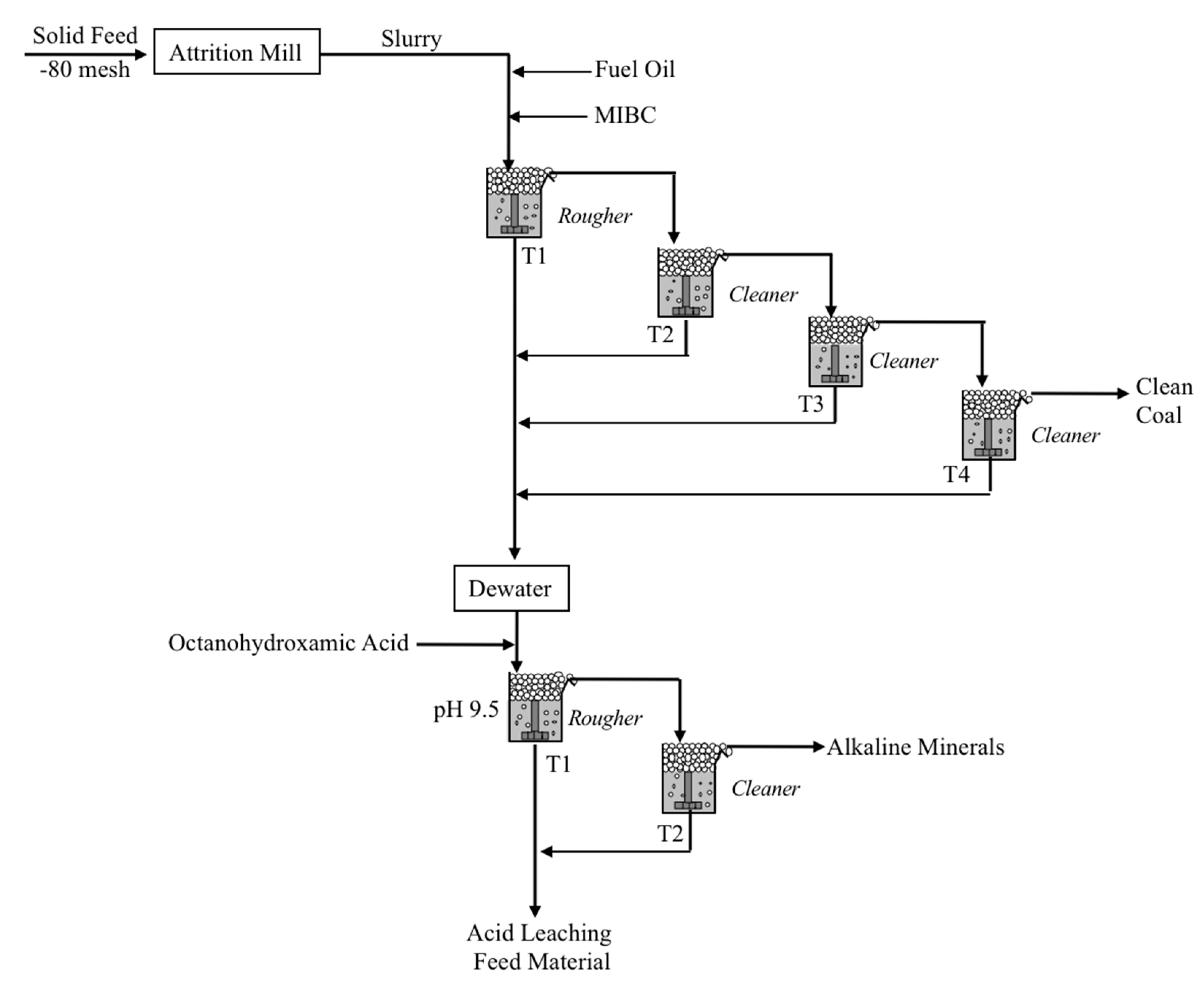
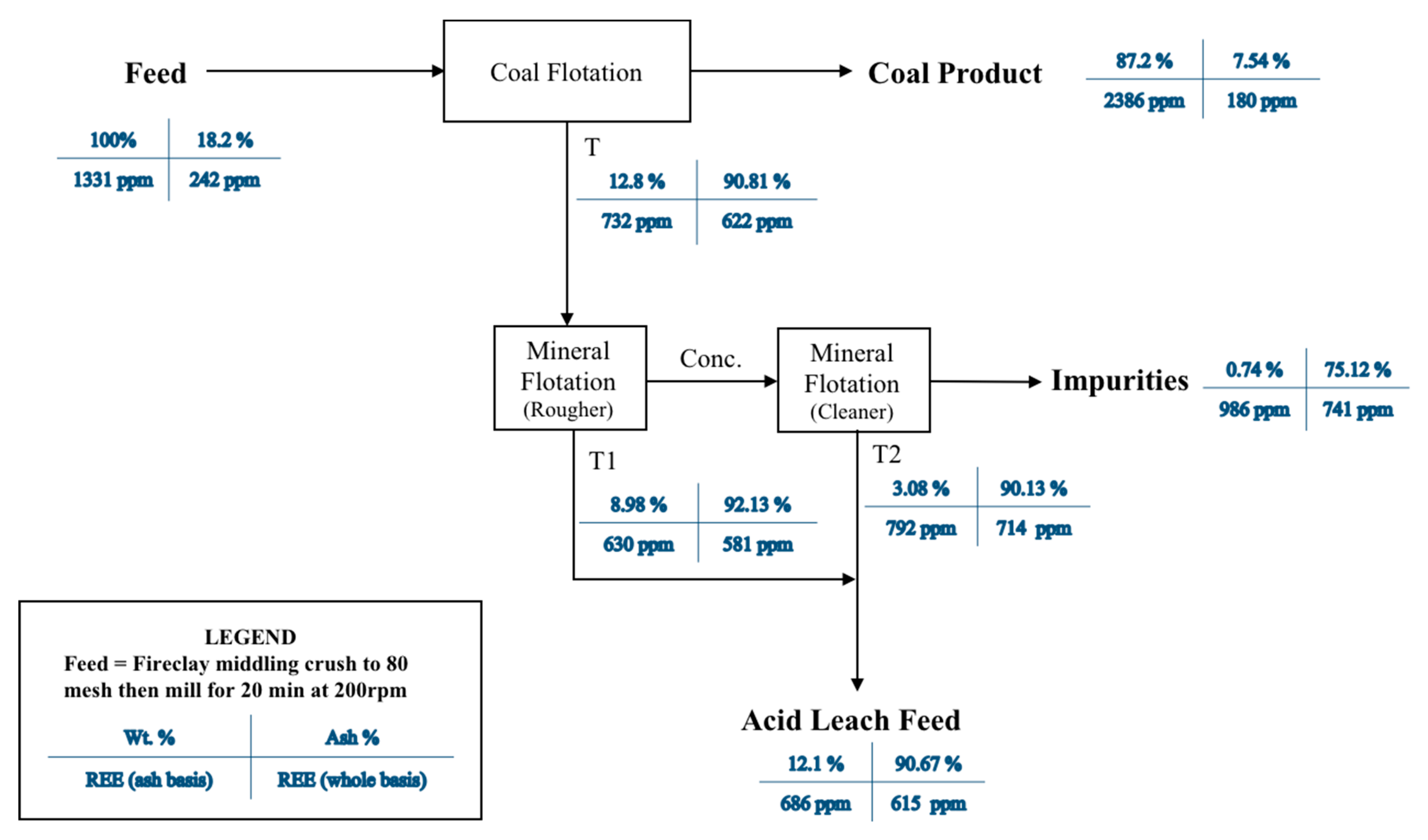
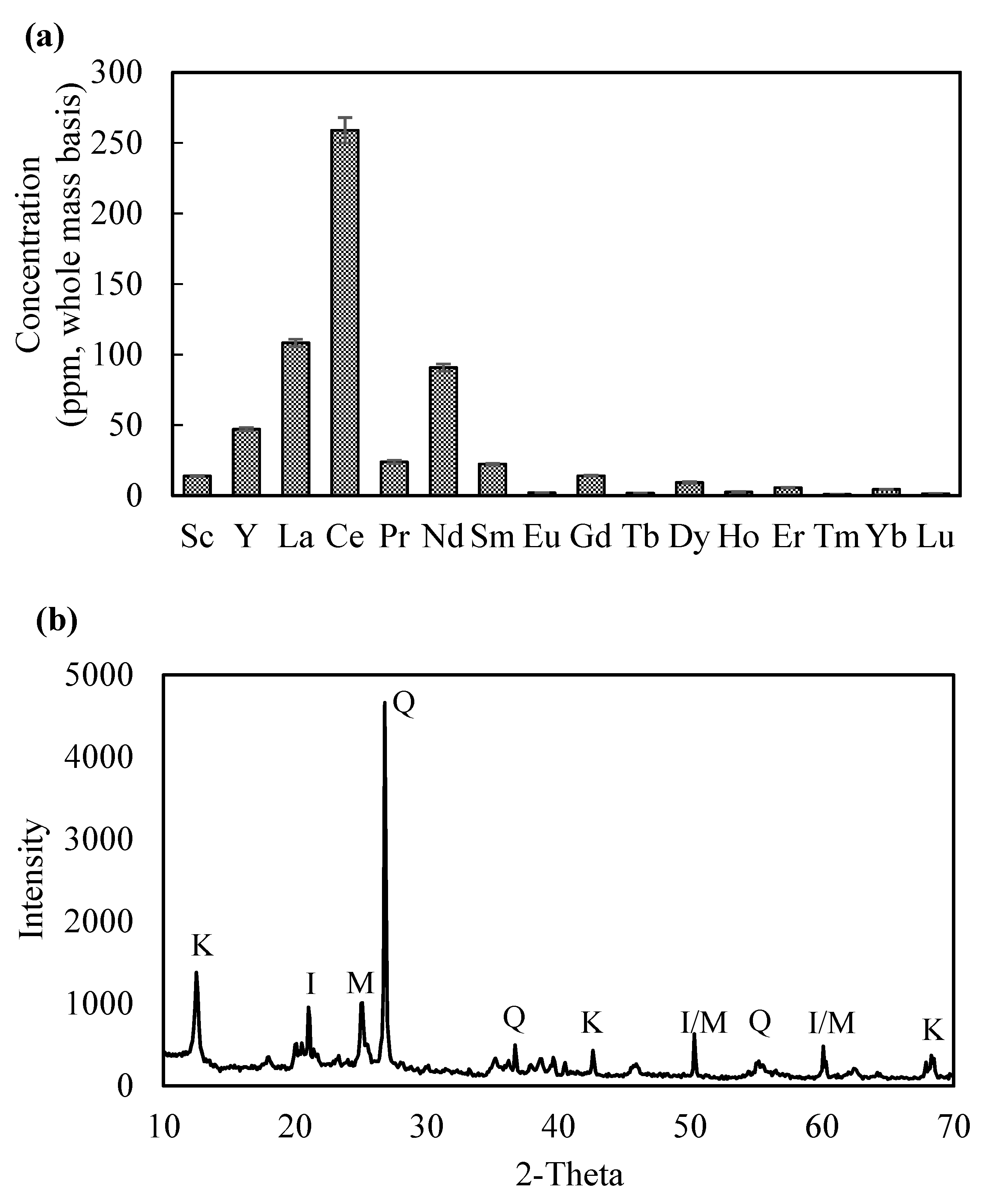
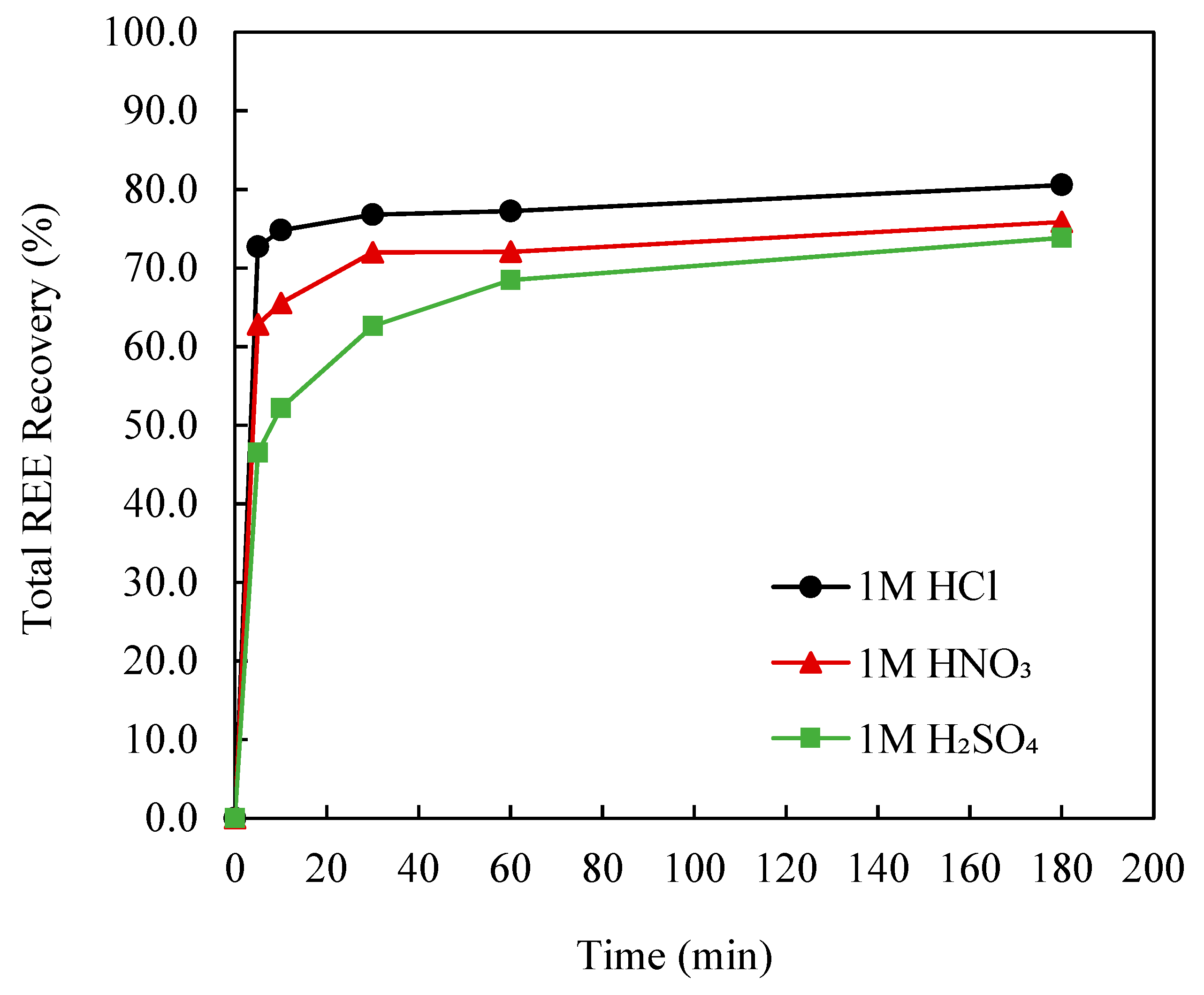
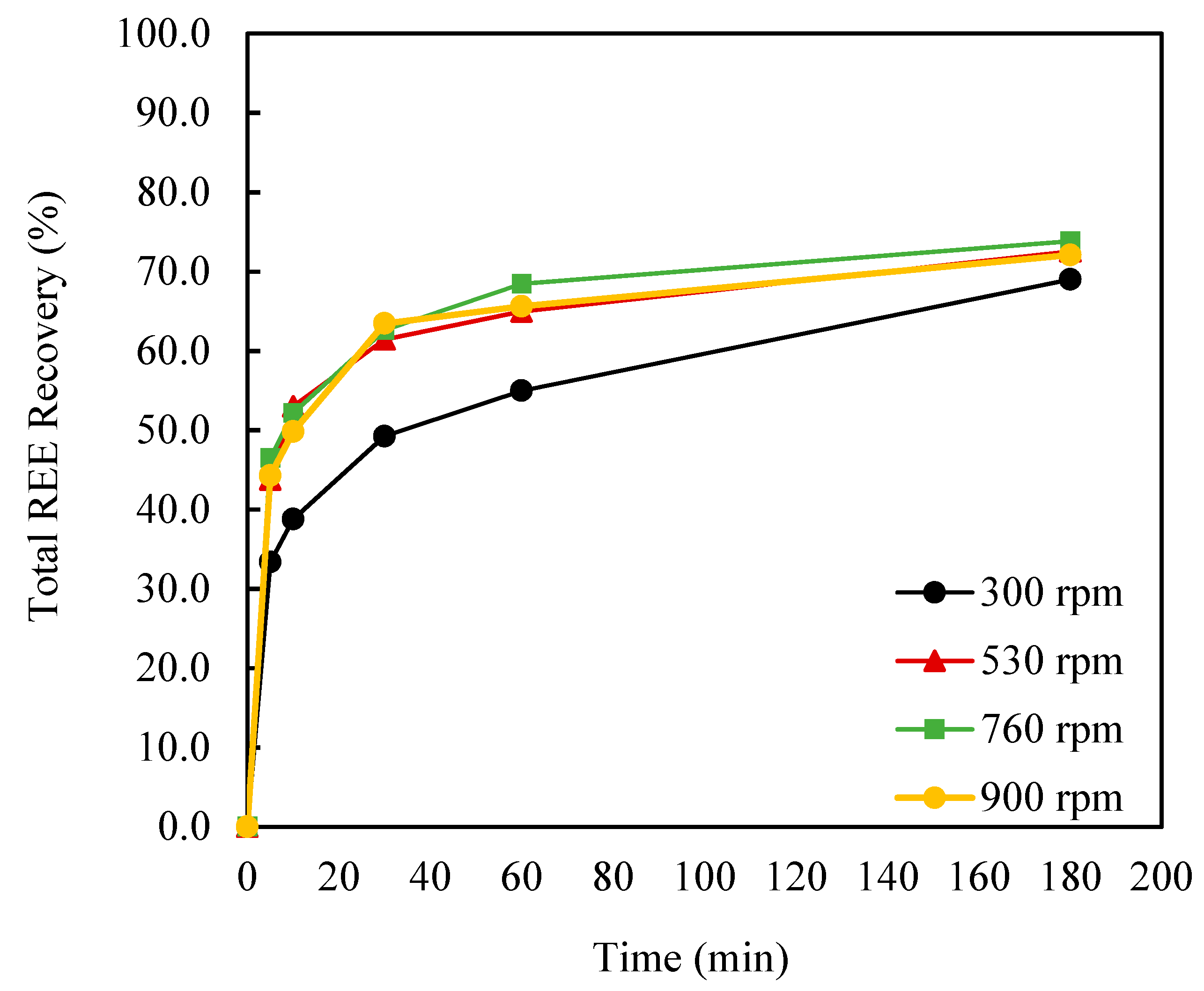
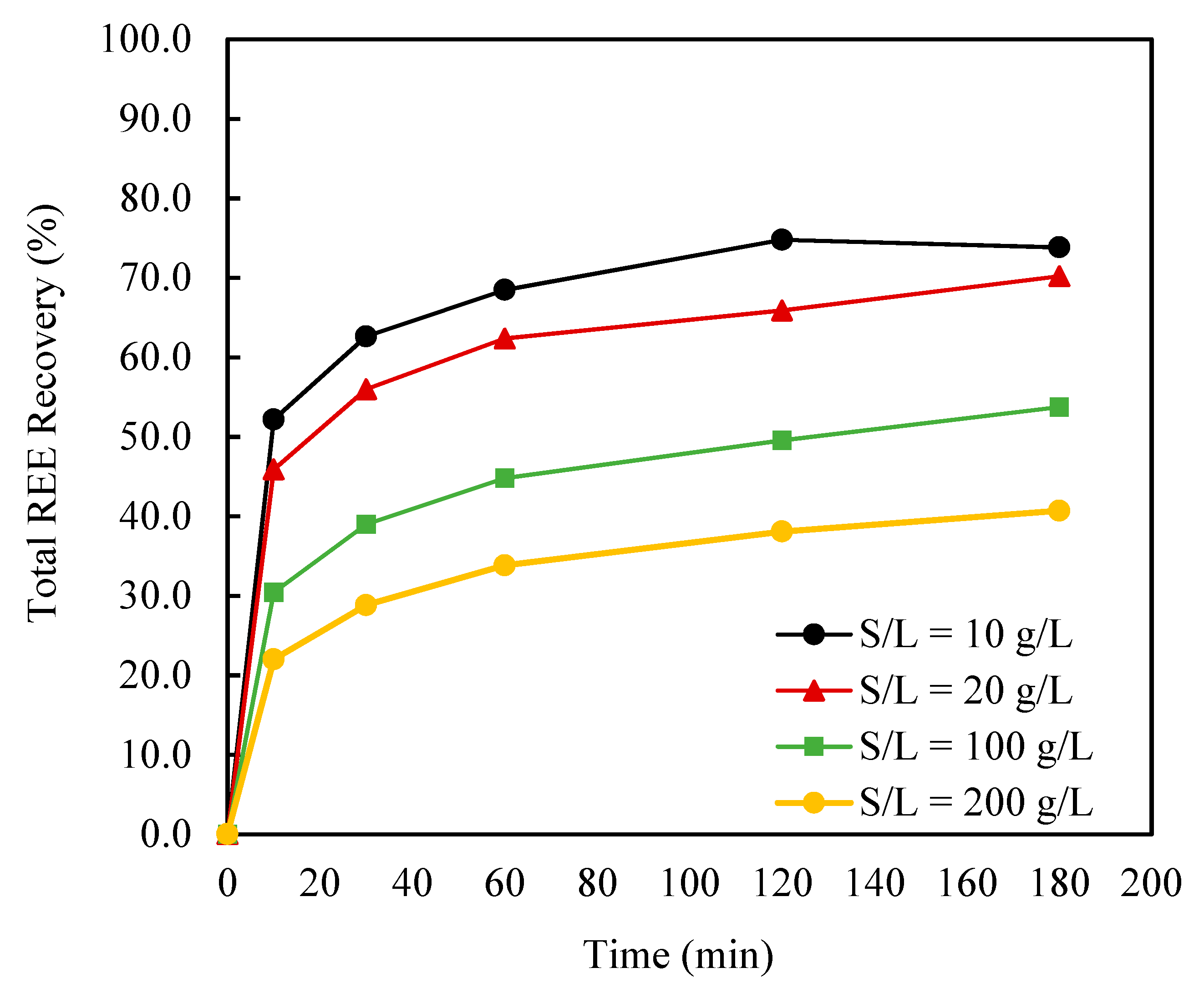
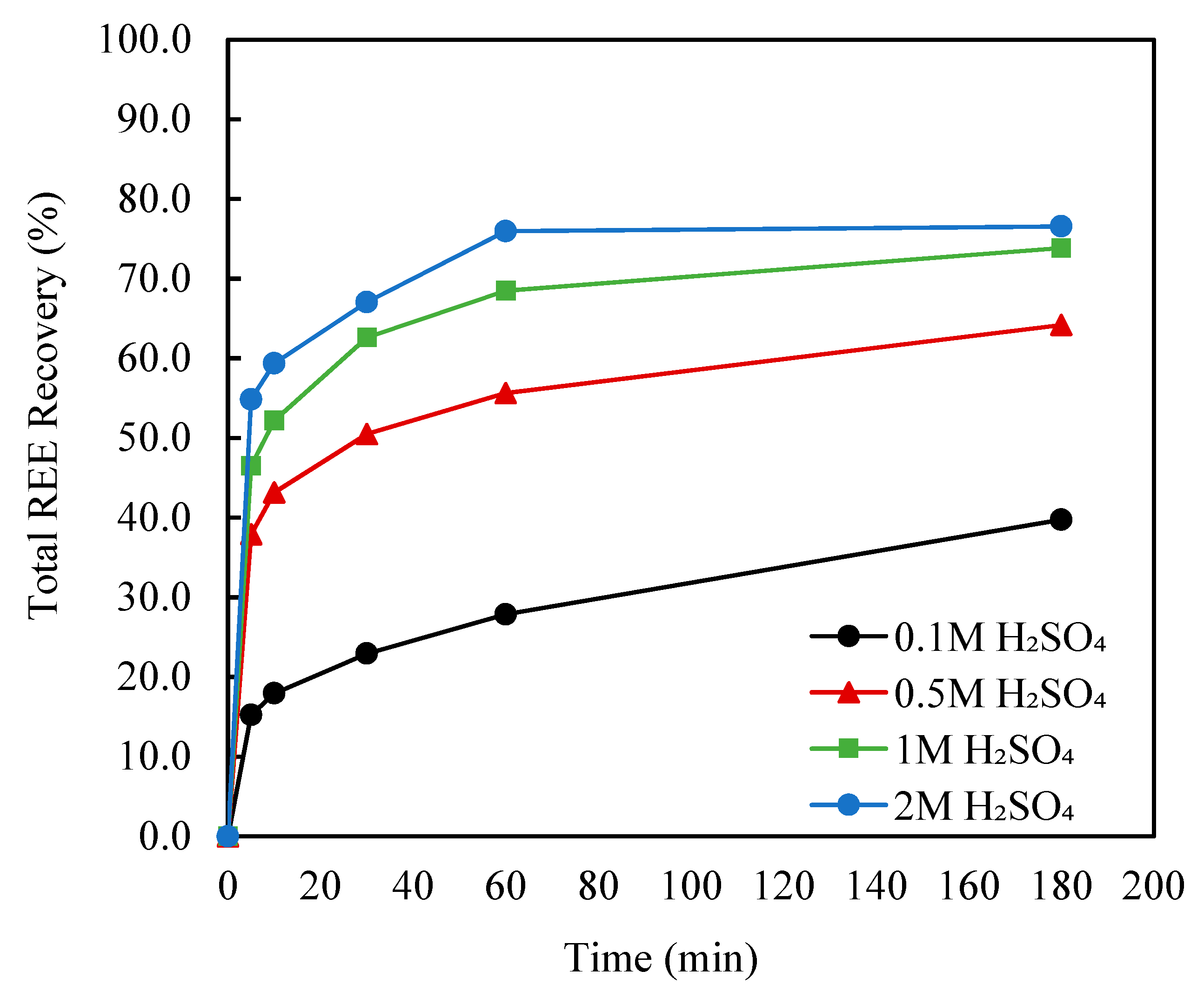

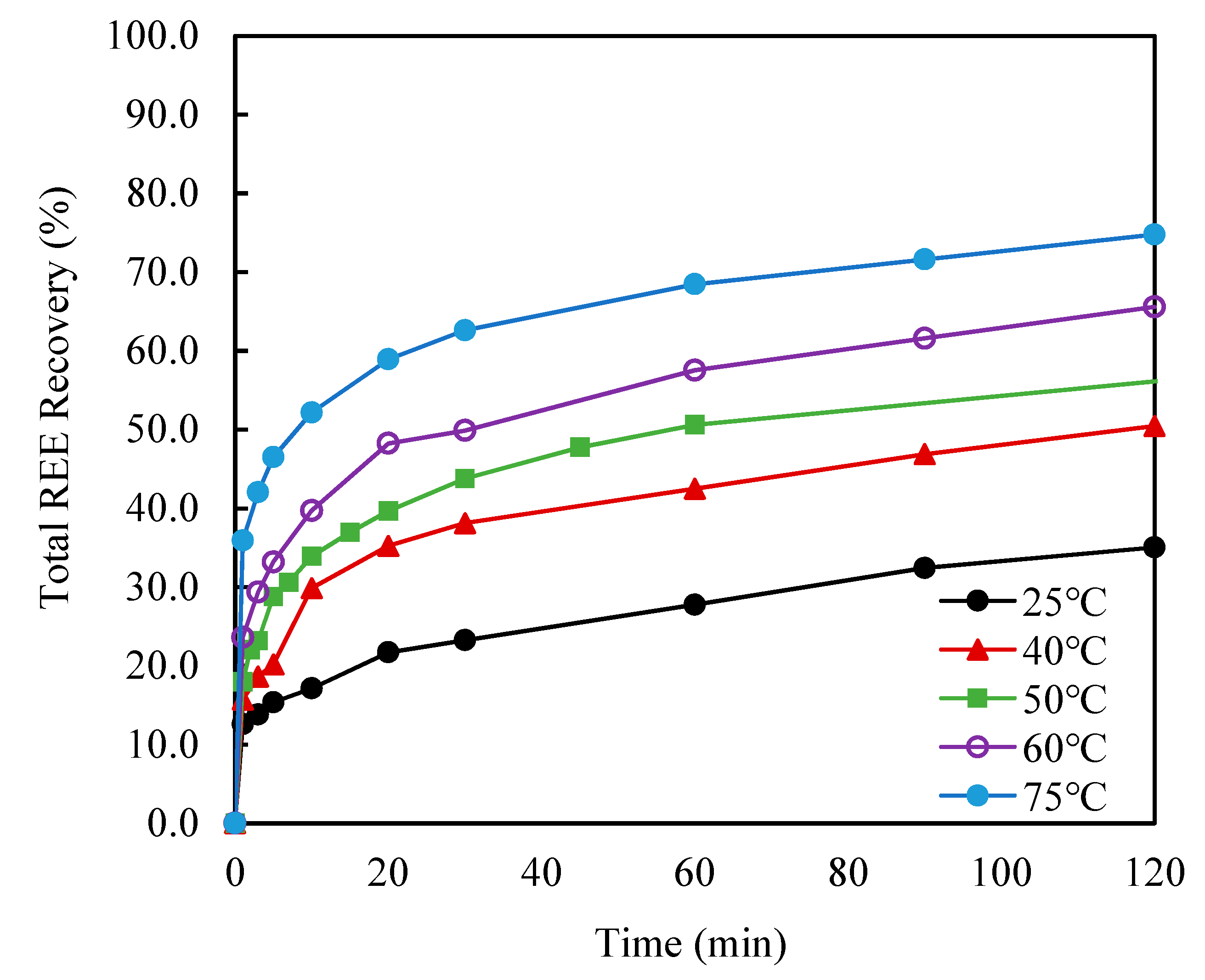
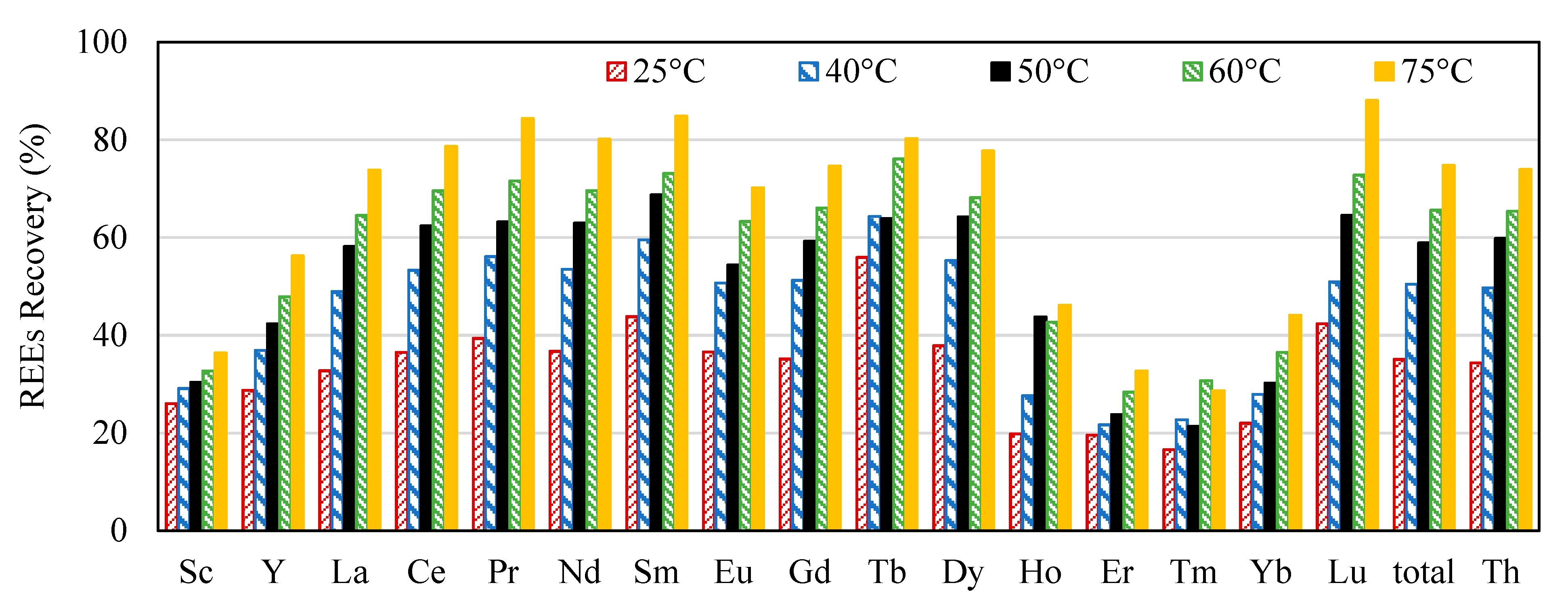
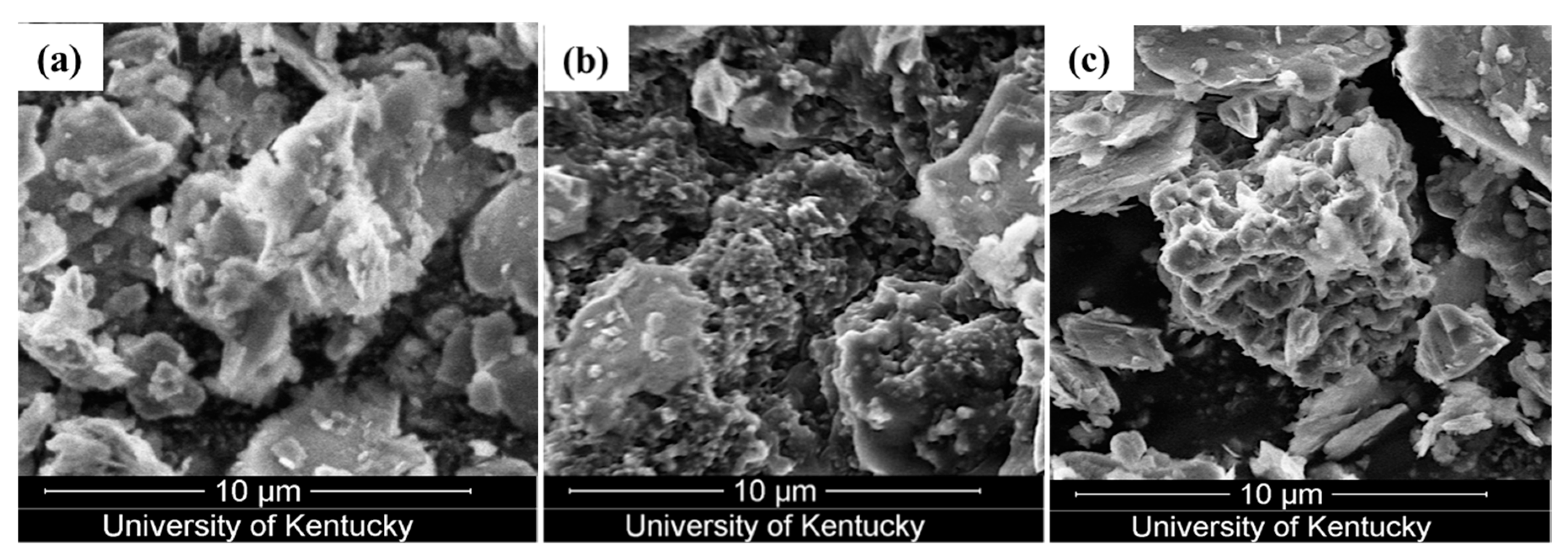
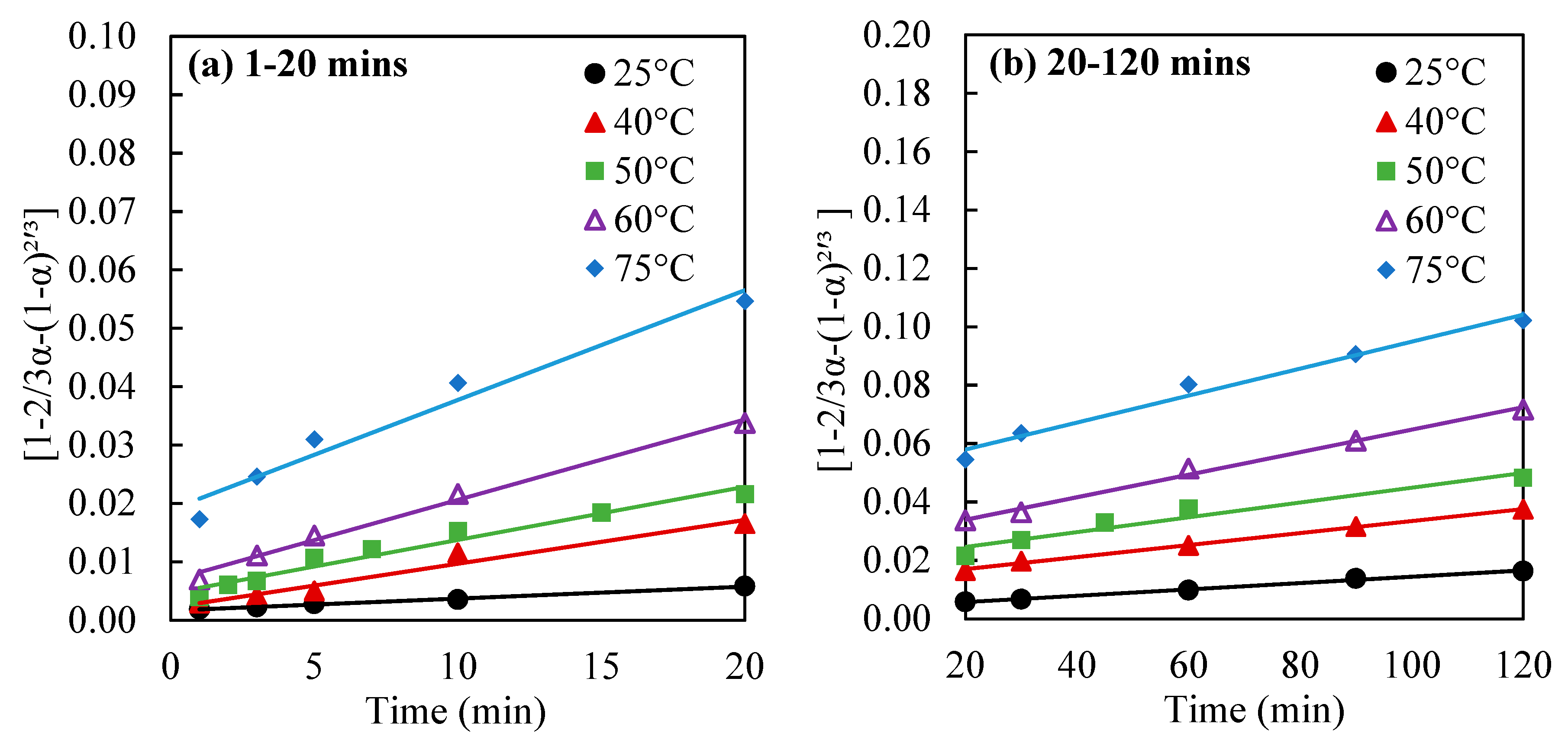

| Attrition Mill | P80 | Flotation | TREE Concentration | Acid Leaching | |||||
|---|---|---|---|---|---|---|---|---|---|
| Grinding Time (min) | Rotor Speed (rpm) | Flotation Feed (micron) | Flotation Tailing (micron) | Tailing Yield (%) | Ash Content (%) | Ash Basis (ppm) | Whole Mass Basis (ppm) | Solid Loss (%) | TREE Recovery (%) |
| Feed | 18.2 | 1331 | 242 | ||||||
| 0 | 0 | 150 | 32.0 | 3.7 | 89.1 | 499 | 444 | 11.9 | 71.2 |
| 2.5 | 150 | 45 | 14.5 | 7.4 | 85.9 | 581 | 499 | 9.9 | 74.8 |
| 5 | 200 | 37 | 10.2 | 9.5 | 87.1 | 609 | 531 | 9.2 | 79.0 |
| 20 | 200 | 13 | 8.7 | 12.8 | 90.8 | 685 | 622 | 16.2 | 83.7 |
| 40 | 200 | 11 | 7.3 | 14.2 | 91.0 | 768 | 699 | 17.2 | 84.3 |
| 60 | 200 | 10 | 6.5 | 13.9 | 91.4 | 771 | 705 | 20.4 | 83.6 |
| 90 | 200 | 9 | 5.0 | 13.6 | 90.9 | 788 | 716 | 24.2 | 82.3 |
| 120 | 200 | 8 | 0.9 | 15.4 | 91.0 | 791 | 719 | 27.9 | 82.0 |
| Temperature | Diffusion 1–20 min | Diffusion 20–120 min | |||||
|---|---|---|---|---|---|---|---|
| °C | K | k | a | R² | k | a | R² |
| 25 | 298 | 0.0002 | 0.0017 | 0.9949 | 0.0001 | 0.0036 | 0.996 |
| 40 | 313 | 0.0007 | 0.0022 | 0.9648 | 0.0002 | 0.0129 | 0.9977 |
| 50 | 323 | 0.0009 | 0.0046 | 0.9616 | 0.0003 | 0.0196 | 0.9402 |
| 60 | 333 | 0.0014 | 0.0068 | 0.9919 | 0.0004 | 0.0262 | 0.9934 |
| 75 | 348 | 0.0019 | 0.0189 | 0.9627 | 0.0005 | 0.0487 | 0.9796 |
| Temperature | Diffusion 1–20 min | Diffusion 20–120 min | |||||
|---|---|---|---|---|---|---|---|
| °C | K | k | a | R² | k | a | R² |
| 25 | 298 | 0.0002 | 0.0016 | 0.9975 | 0.0001 | 0.0034 | 0.9971 |
| 40 | 313 | 0.0005 | 0.0017 | 0.9963 | 0.0002 | 0.0115 | 0.9931 |
| 50 | 323 | 0.001 | 0.0042 | 0.9712 | 0.0003 | 0.0214 | 0.9542 |
| 60 | 333 | 0.0015 | 0.0068 | 0.9929 | 0.0004 | 0.0278 | 0.9928 |
| 75 | 348 | 0.0021 | 0.0198 | 0.9648 | 0.0005 | 0.0571 | 0.9888 |
| Temperature | Diffusion 1–20 min | Diffusion 20–120 min | |||||
|---|---|---|---|---|---|---|---|
| °C | K | k | a | R² | k | a | R² |
| 25 | 298 | 0.0002 | 0.0028 | 0.9593 | 0.00005 | 0.0049 | 0.9634 |
| 40 | 313 | 0.0004 | 0.0032 | 0.9943 | 0.00008 | 0.104 | 0.98 |
| 50 | 323 | 0.0005 | 0.0051 | 0.939 | 0.00009 | 0.0127 | 0.9704 |
| 60 | 333 | 0.0007 | 0.0068 | 0.9803 | 0.0002 | 0.016 | 0.9972 |
| 75 | 348 | 0.0008 | 0.013 | 0.941 | 0.0002 | 0.0251 | 0.9857 |
© 2020 by the authors. Licensee MDPI, Basel, Switzerland. This article is an open access article distributed under the terms and conditions of the Creative Commons Attribution (CC BY) license (http://creativecommons.org/licenses/by/4.0/).
Share and Cite
Yang, X.; Honaker, R.Q. Leaching Kinetics of Rare Earth Elements from Fire Clay Seam Coal. Minerals 2020, 10, 491. https://doi.org/10.3390/min10060491
Yang X, Honaker RQ. Leaching Kinetics of Rare Earth Elements from Fire Clay Seam Coal. Minerals. 2020; 10(6):491. https://doi.org/10.3390/min10060491
Chicago/Turabian StyleYang, Xinbo, and Rick Q. Honaker. 2020. "Leaching Kinetics of Rare Earth Elements from Fire Clay Seam Coal" Minerals 10, no. 6: 491. https://doi.org/10.3390/min10060491
APA StyleYang, X., & Honaker, R. Q. (2020). Leaching Kinetics of Rare Earth Elements from Fire Clay Seam Coal. Minerals, 10(6), 491. https://doi.org/10.3390/min10060491






